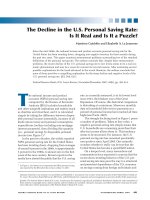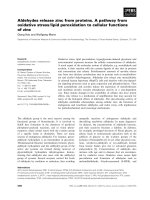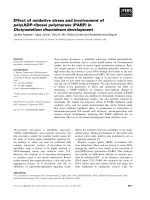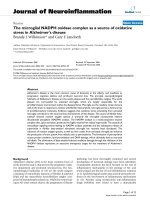Gamma glutamyltransferase is it a biomarker of oxidative stress
Bạn đang xem bản rút gọn của tài liệu. Xem và tải ngay bản đầy đủ của tài liệu tại đây (2.55 MB, 110 trang )
Chapter 1.
Introduction
Cardiovascular disease is one of the leading causes of death globally. Every year, an
estimated 17 million people die from heart disease globally. In Singapore,
approximately 15 people die of heart disease every day and such deaths accounted for
32.4% of the total death rate in 2008. There are many forms of cardiovascular
diseases, one of which is atherosclerosis. Cardiovascular mortality and morbidity are
highly correlated with atherosclerotic disease.
Atherosclerosis is a chronic process involving oxidized low-density lipoproteins (oxLDL) in the vessel wall. The body’s immune response towards damage is to release
macrophages and T cells to engulf these ox-LDLs, forming foam cells. These cells
eventually rupture thus releasing more oxidized cholesterol. The accumulations of
substances such as cholesterol, fats, calcium and fibrin eventually build up into a
plaque, causing the narrowing of the arteries, the loss of elasticity of the arterial walls,
reduced blood flow and increased blood pressure1, 2.
Gamma- glutamyltransferase (GGT) is known to be involved in the oxidation process
of LDL and active GGT has been observed in atherosclerotic plaques3, 4. Prospective
studies have also recently shown that plasma GGT levels can apparently predict the
outcome of mortality in cardiovascular disease over time5.
1.1 Free Radicals
A free radical refers to any species containing one or more unpaired electrons, each
occupying an atomic or molecular orbital by itself (Halliwell & Gutteridge, 2007).
The superscript dot behind the chemical name indicates that a species is a free radical
(eg. O2). The presence of one or more unpaired electrons is able to cause free
1
radicals to be attracted towards a magnetic field. In general, free radicals are more
reactive than non-radicals, even though the reactivity of radicals is widely variable6.
There are free radicals present in vivo. However, most molecules in vivo do not exist
as free radicals, which can be created from losing or gaining an electron from nonradicals7 among other mechanisms. Free radicals and other reactive species are
continuously generated in vivo during physiological and pathological processes.
1.2 Reactive Species
1.2.1 Reactive Oxygen Species
Reactive species is a collective term, which includes oxygen radicals and non-radical
derivatives of oxygen such as H2O2 or hypochlorous acid (HOCl). The table 1.2.1.1
below shows nomenclature of reactive species of oxygen found in vivo (adapted from
Halliwell)7.
Reactive Oxygen Species
Radicals
Non-Radicals
Superoxide, O2
Hydrogen peroxide, H2O2
Hydroperoxyl, HO2
Peroxynitrite, ONOO
Hydroxyl, OH
Peroxynitrous acid, ONOOH
Peroxyl, RO2
Nitrosoperoxycarbonate, ONOOCO2
Alkoxyl, RO
Hypochlorous acid, HOCl
Carbonate, CO3
Hypobromous acid, HOBr
Carbon Dioxide, CO2
Ozone, O3
Table 1.2.1.1 Nomenclature of ROS of both radicals and non-radicals.
2
Reactive oxygen species (ROS) such as H2O2, O2 and OH are generated in cells
via several pathways8. Cellular energy is dependent on ATP production through
electron transport reactions in which O2 accepts elections and H+ is reduced to water.
The electron transport though the mitochondrial respiratory system is highly efficient
(shown in figure 1.2.1.1). However, the leakage of an electron to O2 results in the
production of O2. This leakage is believed to be mediated by complex I, coenzyme
Q and ubiquinione and its complexes9. Therefore, mitochondria are thought to be a
major site of ROS production in vivo10.
Figure 1.2.1.1 shows the metabolic pathways of ROS formation. ROS such as H2O2,
O2 and OH are generated in cells via several pathways. ROS can also be generated
by ionizing radiation. O2- is generated from a number of pathways such as leakage
of electrons from mitochondria, cytochrome P450 reductase, hypoxanthine/ xanthine
oxidase, NADPH oxidase, lipooxygenase and cyclooxygenase. Superoxide dismutase
3
then converts O2 into H2O2, which is then degraded to H2O by glutathione
peroxidase and catalase. Thioredoxin (TRX) has H2O2 reducing properties and
refolding oxidized protein function. H2O2 produces highly reactive radical OH by
the Fenton or the Haber – Weiss reactions (Figure is adapted from Kamata H and
Hirata H)8.
1.2.2 Hydrogen Peroxide
H2O2 is a pale blue covalent viscous liquid that boils at 150oC. Figure 1.2.2.1 (below)
shows the structure of H2O2 in its gaseous and solid state (Adapted from
www.commons.wikimedia.org).
Figure 1.2.2.1. Structure of H2O2 in gaseous and solid state, varying in the degrees in
angle between H-H atoms and H-O atoms.
H2O2 plays an important role as an inter- and intra-cellular signaling molecule11, 12. As
such, a basal level of H2O2 must be present in the cells. H2O2 is generated in almost
all tissues and at significantly high rates in mitochondria by monoamine oxidase in
the brain or by dismutating O2 from the electron transport chain via superoxide
dismutase (SOD) in the equation below.
(2 O2 + 2 H+ → H2O2 + O2)
Cellular H2O2 and other peroxides are eliminated by seleno-enzyme SH peroxidase4
catalysed reduction, using glutathione (GSH) as substrate13,
14
. H2O2 reacts only
moderately with other biological molecules, however it is unable to directly oxidize
DNA, lipids and most proteins (except hyper- reactive thiol groups or methionine
residues7). H2O2 is readily converted to OH, either by –ray or ultraviolet (UV) light
radiation15. Thus H2O2 can be highly reactive in the presence of Fe and Cu ions,
inducing oxidative damage on cells through Fenton reaction or Haber- Weiss reaction
generating OH. The Haber-Weiss reaction generates OH from H2O2 and O216. It
can occur in cells and may be due to oxidative stress. The first step in the catalytic
cycle involves the reduction of ferric ion to ferrous:
Fe3+ + O2 Fe2+ + O2
The Fenton reaction involves the formation of hydroxyl radicals (OH) from H2O2 in
the presence of Fe2+ or Cu+ ions7:
H2O2 + Fe2+ Fe (III) + OH- + OH
H2O2 + Cu+ Cu2+ + OH- + OH
SOD converts O2 into H2O2, which in turn is degraded to H2O by several cellular
enzymes15 such as catalase and GSH peroxidase in the GSH pathway.
H2O2 when present in low concentration, is able to enhance proliferation of certain
cell types7. However, the concentration of H2O2 at about 10-100 µM is toxic to cells,
causing either senescence or apoptosis in vitro.
Some enzymes are known to generate H2O2. Ascorbate and certain flavonoids are
compounds that are commonly known to generate H2O2 in cell culture media. This
5
H2O2 generation may cause cell culture artefacts resulting in misinterpretation of the
results with effects on cells17.
1.3 Antioxidant Defence Enzymes
1.3.1 Superoxide Dismutases (SODs)
Exposure to free radicals led organisms to evolve an antioxidant defence system. The
discovery of SODs provided the basis for the current understanding of antioxidant
defence since it led to the postulation of the superoxide theory of O2 toxicity and the
realization that free radicals are important metabolic products18. There are a few
forms of SODs such as CuZuSOD, MnSOD, FeSOD, an E. coli hybrid SOD enzyme
containing subunits of manganese and iron in the same molecule18, cambialistic
SOD19 and NiSOD20. Of all these SODs, the 2 most important SODs are CuZnSOD
and MnSOD as they are present in animal tissues and play a more important role in
antioxidant defence.
CuZnSOD is a superoxide dismutase containing copper and zinc. SOD enzymes are
highly efficient in removal of O2, however they can promote a few other reactions
in vitro18, 21. An example is when nitroxyl anion (NO-) reduces Cu2+ in the presence of
O2, CuZnSOD can catalyze conversion of NO- to NO22.
NO- + O2 + 2H+ NO+ H2O2
Most CuZnSODs are rather resistant to heating, attack by proteinase and denaturation
and are present in most eukaryotic cells. CuZnSOD is located in the cytosol in animal
cells, however some appears to be present in lysosomes, nucleus and the space
between inner and outer mitochondrial membranes18, 23.
6
Another form of SOD is known as Manganese SOD (MnSOD). It is also known as
SOD2. It contains manganese in its active site as Mn (III) in the ‘resting’ enzyme.
Unlike CuZnSOD, almost all MnSODs are more labile to denaturation by heat or
organic solvent/ detergents7. MnSOD are widely present in bacteria, plants and
animals. For most animals’ tissues, MnSODs are largely found in the mitochondria.
The relative amount of MnSOD and CuZnSOD present in animals are tissue and
species- specific18.
1.3.2 Glutathione Peroxidase family (GPx)24, 25
The glutathione peroxidases (GPx), selenium- dependent enzymes26 are capable of
reducing H2O2 to H2O with the oxidation of GSH.
H2O2 + 2GSH GSSG + H2O
Glutathione peroxidase was first discovered in animal tissues in 1957 and is less
common in plants or bacteria24. The GPx enzymes can be found across different
animal tissues (see table 1.3.2.1 below)7 and are widely specific for GSH as a
hydrogen donor. GPx enzymes can be inhibited by mercaptosuccinate
27
and are able
to act on peroxides other than H2O2, reducing them to alcohols24, 25.
LOOH +2GSH GSSG + H2O + LOH
There are at least 4 types of GPxs
7, 25
, one of which is a ‘classical’ enzyme often
known as cytosolic GPx or GPx1. GPx3 is a glycoprotein and low levels can be found
in mammalian plasma. It can also be found in other extracellular fluids such as milk,
seminal fluid, amniotic fluid and. it originates mainly from the kidney. Another type
of GPx is found in cells lining the gastrointestinal tract. It is commonly known as the
7
intestinal GPx or GPx2. GPx2 functions to metabolise peroxides presence in ingested
food lipids and those generated during lipid oxidation in the intestine. The human
liver has been found to contain GPx2, GPx1 and GPx4. GPx4 is known as the
phospholipid hydroperoxide glutathione peroxidase. It has the unique ability to reduce
H2O2, synthetic organic peroxides, fatty acids
and
esterified
cholesterol
hydroperoxides. GPx4 can reduce peroxidized fatty acids within membranes and
lipoproteins to alcohols.
Table 1.3.2.1 shows the presence of glutathione and other enzymes in different
organisms such as different parts of rat tissues, human tissues and different conditions
of E.coli. The data is compiled from a wide range of publications7 and the studies
show that there is low or no GPx levels present in spinach chloroplasts and bacteria
and high levels of GPx in both rat and human liver. (Adapted from Free Radicals in
Biology and Medicine, Barry Halliwell and John Gutteridge7)
1.4 Oxidative Stress
8
Cellular thiol redox state is a crucial mediator for multiple metabolic, signalling, and
transcriptional processes in cells, balancing between normal oxidising and reducing
conditions, which is essential for the normal function and survival of cells28. However
when there is an alteration in the redox homeostasis, due to the excessive production
of ROS/RNS (i.e increased exposure of O2 or excessive activation of systems
producing RS)7 or that there is an impairment of antioxidant defence system (due to
mutations affecting endogenous antioxidant defences or diminished essential dietary
constituents)28, oxidative stress occurs (Figure 1.4.1).
Figure 1.4.1 shows the imbalance of ROS/RNS and antioxidants, disrupting the redox
homeostasis and eventually resulting in oxidative stress. (Adapted from Dalle-Donne
et al, 200828).
The term oxidative stress was first coined from the title of the book – Oxidative
Stress, in 198529 and later defined as a disturbance in the pro-oxidant- antioxidant
balance in favour of the former30, which leads to oxidative damage. The consequence
of oxidative stress is dependent on cell types and severity of oxidative stress level (as
9
shown in figure 1.4.2 below), which may result in increased proliferation, adaptation,
cell injury, senescence or cell death7.
Figure 1.4.2 showing how cells respond to oxidative stress. (Adapted from Halliwell,
2000.31) The diagram shows that resting cells are usually in a reduced state and as the
oxidative stress increases, so does the damage to the cells to the point of severe
mitochondrial damage, excessive DNA damage and apoptosis or other modes of cell
death.
1.5 Glutathione
Glutathione is almost ubiquitous in cells32 and plays a key role in reduction processes
by maintaining thiol groups of intracellular proteins26. It is also known to be involved
in many metabolic processes such as maintaining communications betweens cells
though gap junctions33, preventing protein-SH groups from oxidising and crosslinking. Although these functions are associated with protection against RS,
maintenance of a suitable thiol redox balance with low- molecular- weight and protein
thiols are also crucial for cellular homeostasis32.
10
GSH is a tripeptide with sequence -Glutamyl-Cysteine-Glycine as shown in figure
1.5.1 below. The oxidation of the thiol group from the cysteine moieties of 2 GSH
molecules, results in the formation a of disulfide bond to form GSSG26. Because of
the structure of GSH and GSSG, both of them are water-soluable26.
Figure 1.5.1. Structure of Glutathione, taken from Free Radicals in Biology and
Medicine, Barry Halliwell and John Gutteridge7.
Glutathione present in mammalian tissues is mostly in the reduced form; the ratio of
reduced to oxidized GSH in normal cells is very high (100:1)7.
1.5.1 Function of GSH
Glutathione has two major functions; (1) as a substrate for GPx- mediated reduction
of oxygen free radicals and (2) for biotransformation of exogenous compounds
catalyzed by glutathione-S-transferases26. Glutathione also plays an important role in
11
protecting against ionizing radiation34, assists in supplying copper to CuZnSOD35 and
acts as a cofactor for enzymes in different metabolic pathways36, 37. Glutathione also
plays a part in protein folding as well as degradation with the cleavage of disulphide
bonds, of which insulin is an example38.
Glutathione is known to behave as an antioxidant by scavenging RS intracellularly,
reacting to generate thiyl (GS) groups and O239, 40. The O2 generated could be
removed by SOD and the GSSG can be reconverted into GSH by glutathione
reductase catalysing the reaction: GSSG + NADPH + H+ 2GSH + NADP+. The
reduction potential of GSSG to GSH, however varies from cytoplasm to endoplasmic
reticulum to mitochondria due to concentration and to pH41. Glutathione’s reaction
with ONOO can somehow convert ONOO to NO42. Glutathione also chelates
copper ions and diminishes the generation of OH from H2O243.
The need for GSH increases as oxidative stress increases. Therefore, it is important to
maintain an adequate level of intracellular glutathione in the reduced (GSH) state
under normal conditions in vivo.
1.5.2 Glutathione synthesis and degradation
Glutathione is synthesized in the cytoplasm of all cells with its highest production and
disposition in the liver cells7, 26. It is known that GSH is secreted into the plasma by
the liver and for GSH synthesis in other tissues via different transporters44.
Mitochondria, containing 10- 20% of the total cellular GSH, also require transporters
in the inner membrane to bring GSH from the cytoplasm into the matrix45.
Glutamate-cysteine ligase (also known as -glutamylcysteine synthetase, GCS) is the
first step in GSH synthesis and the dipeptide product is converted to GSH by
glutathione synthetase as shown below (Adapted from Dalton et al)46.
12
L-glutamate + L- cysteine + ATP L--glutamyl-L-cysteine + ADP + Pi
L--glutamyl-L-cysteine + ADP +Pi +glycine +ATP GSH + ADP + Pi
Cells can make the necessary cysteine from methionine or take it up from the
surrounding fluids as cysteine and/ or cystine (disulfide form), which will then be
reduced to cysteine in the cell7. Different transporters are used for cysteine and
cystine. However both cystine and glutamate share the same transporter. Therefore,
high levels of extracellular glutamate can decrease the synthesis of GSH in some cell
types due to the slowing down of cystine entering the cells47.
Mammalian cells however are unable to take up GSH as a whole and it therefore
needs to be broken down into a glutamyl moiety, cysteine and glycine. The first step
requires an enzyme called -glutamyltranspeptidase (or -glutamyltransferase or
GGT), which is located on the plasma membrane with its active site facing outwards
and acting on extracellular GSH. This is done by removing the -glutamyl moiety
either by hydrolysis or transferring to an acceptor7. The cysteine- glycine dipeptide is
hydrolysed by dipeptidase to give cysteine and glycine for uptake into the cell. The glutamylamino acid is also taken up and converted to 5- oxoproline, which is then
converted to glutamate (glutamic acid). In the case of glutamyl-cysteine, it can be
directly converted to GSH48. The figure 1.5.2.1 below shows the synthesis and
degradation of the glutathione cycle.
13
Figure 1.5.2.1 shows biosynthesis and degradation of the glutathione cycle. (a)
Glutamylcysteine synthetase; (b) glutathione synthetase; (c) -glutamyl
cyclotransferase; (d) oxoprolinase; (e) -glutamyltranspeptidase; (f) dipeptidases
(including leucine aminopeptidase). This diagram is adapted from late Professor
Alton Meister and the American Society of Biochemistry and Molecular Biology.
1.5.3 Redox Signaling
Thiol groups are essential for protein function and total level of protein-SH in cells.
Protein-S-glutathionylation is defined as the formation of mixed disulfides between
an exposed protein thiol and glutathione. This process occurs in response to cells
undergoing oxidative stress26. Therefore the ability to reverse this process is important
to cells in response to oxidative damage and may have a role in redox signalling.
Reverse glutathionylation or deglutathionylation can be achieved by glutaredoxin
14
proteins (GRx). Glutaredoxin, also known as thioltransferase, was originally
discovered as a cofactor of ribonucleotide reductase in E. coli but was later found to
be present in many organisms and animals49, 50. Glutaredoxin can be found in both
mitochondria and cytosol and can be reduced directly by GSH. It is involved in
catalysing thiol-disulphide interchange and the repair of glutathionylated proteins.
There are 2 types of mammalian GRx; GRx1 is located in the cytoplasm of the cells,
while GRx2 is found to be analogous to the glutathione recognition site of GRx1 and
is directed to the mitochondria and nucleus. Both GRx1 and GRx2 are important for
modulating the S-glutathionylation status and corresponding activities not just for
mitochondrial and nuclear proteins, but also for certain nuclear transcription factors
that translocate from cytosol to nucleus49.
1.5.4 Effects of deficiencies in GSH metabolic enzymes
Glutathione metabolism plays an important part in the development of humans and
animals. Deficiencies in GSH metabolic enzymes can lead to oxidative stress, which
in turn plays a key role in aging and pathogenesis conditions such as seizure,
Alzheimer's disease, Parkinson's disease, liver disease, sickle cell anemia, HIV,
AIDS, cancer, heart attack, stroke, and diabetes47. Patients with glutathione reductase
deficiency exhibit cataract and premature aging similarly to mice treated with
buthionine sulphoximine, an inhibitor of glutamylcysteine synthetase47. Knockout of
-GCS in mice has proven to be embryonic lethal46. Mice lacking GGT showed
increased plasma and urinary GSH together with signs of ageing and myocardial
infarction, which signifies this enzyme’s great importance in the maintenance of
tissue GSH levels in mice46. Human lacking GGT, on the other hand, showed normal
15
cellular GSH levels, elevated GSH plasma levels and few symptoms as far as they
have been studied47.
1.6 Quinones
Quinones is a general term for a ubiquitious class of compounds which are common
in several natural products and endogenous biochemicals or generated through
metabolism of hydroquinones and/ or catechols51. Some quinones are potent redox
active compounds, whereby they can undergo enzymatic (i.e., P450/P450 reductase)
and non- enzymatic redox cycling with their corresponding semi- quinones radicals,
resulting in superoxide anion radical generation52-54.
Quinones and semiquinones are able to generate OH from H2O2 by enzymatic or
spontaneous dismutation of superoxide anion radicals, involving iron ions or other
transition metals51. Quinones are also Michael acceptors such that damage due to
these species sometimes results from covalent binding with cellular nucleophiles. For
example, many quinones can react readily with sulfur nucleophiles, such as GSH or
cysteine residues on proteins, leading to depletion of cellular GSH levels and/ or
protein alkylation51.
Quinones exist naturally and can be found in cigarette smoke and widely in nature55.
Semiquinones undergo redox inter- conversion to quinones and hydroquinones to
produce O2 and H2O2. Quinones can be used as predator repellents56, 57, in cancer
chemotherapy58 and as antibiotics59,
60
. Superoxide can exist in equilibrium with
quinones and semiquinones (shown below).
Semiquinone + O2 Quinone + O2
16
Quinones can play roles both as scavengers and generators of O2, which is
dependent on the position of equilibrium and pH, since degree of protonation affects
their reduction potential51,
61
. Dismutation of O2 in aqueous solution favors the
synthesis of semiquinone and O2 by removing O248.
Quinones also have a role in complex III of the electron transport chain in the
mitochondria, as the hydrophobic coenzyme Q (ubiquinone or CoQ). The quinone
ring of the coenzyme Q can be reduced to a quinol in a 2e reaction62:
Q + 2e +QH2
The operation of the Q cycle in complex III results in the reduction of cytochrome c,
oxidation of ubiquinol to ubiquinone, and the transfer of four protons into the
intermembrane space63. Ubiquinol (QH2) binds to the Qo site of the complex III via
hydrogen bonding to His182 of the Rieske iron-sulfur protein and Glu272 of
cytochrome b. Ubiquinone (Q), in turn, binds the Qi site of complex III. Ubiquinol is
divergently oxidized to the Rieske iron-sulfur protein and to the bL heme. This
oxidation reaction produces a transient semiquinone before complete oxidation to
ubiquinone, which then leaves the Qo site of complex III64, 65.
1.6.1 Mechanism of quinone toxicity
Quinones can be toxic to cells via two mechanisms- reaction with glutathione (GSH)
and redox cycling51. Quinones and semiquinones may react with GSH and –SH
groups on proteins. The reaction with GSH may be non-enzymatic and/ or can be
catalysed by glutathione- S- transferase (GST) enzymes, resulting in GSH depletion
in the cell. This GSH depletion may result in renal failure due to conjugates of
hydroquinones interacting with GSH, thus causing oxidative stress51. Redox cycling
refers to a compound continuously being reduced and reoxidized by O2 to generate
17
O2. Most of the O2 will be converted to H2O2, which will be dealt by the
glutathione cycle7.
1.6.2 Menadione
Menadione is a synthetic compound lacking the isoprenoid side- chain on the vitamin
K (a quinone). However, it still exhibits vitamin K activity in animal tests and is thus
named as vitamin K37. The structure of menadione is shown below in figure 1.6.2.166.
Menadione is able to cause haemolysis in glucose-6- phosphate dehydrogenase
deficiency by oxidising and precipitating oxyhaemoglobin protein, forming
semiquinone67. Fischer-Nielsen and colleagues68 showed that a high concentration of
menadione is able to deplete GSH and increase the formation of O2 and H2O2 in rat
hepatocytes. This also resulted in cell membrane blebbing and increased intracellular
free Ca2+ due to oxidative stress69. Menadione is able to cause DNA damage indirectly
via Ca2+- dependent nucleases68.
Figure 1.6.2.1. Structure of menadione, taken from Helmenstine A.M66.
1.7 Gamma glutamyltransferase
1.7.1 Gene
18
Gamma glutamyltransferase (E.C.3.2.2.2) is an enzyme that can be found widely in
bacteria70,
71
, plants72,
73
and the animal kingdom ranging from nematodes74 to
humans. In humans, the GGT genes are located on chromosome 22q1175, 76. There are
seven or more GGT genes present in humans77, 78, however only one gives rise to
complete and functional protein. Although rodent and human GGT genes may show
similarities in many ways such as exonic structures and existence of multiple forms of
mRNA79, rodent GGT genes appear to be single-copy genes that have different
sequences from the human genes80. GGT genes have many promoters and gene
transcripts giving rise to the same protein. However, this is thought to be tissuespecific and also occurs during different phases of development77, 78. The difference in
genetic expression is closely related to the metabolism of GSH81.
1.7.2 Protein
The translation regulation by the 5’ untranslated region of a GGT mRNA, was
initially found using HepG2 cells, and appears to serve as a tissue- specific
translational enhancer82. Gamma- glutamyltransferase gene is translated into a single
precursor protein that is catalytically inactive83, which undergoes an autocatalytic
process into a heavy and light chain84. The heavy chain, which has the aminoterminal sequence, has a single intracellular transmembrane domain that anchors itself
to the cell membrane. The light chain, which contains the active site, is situated in the
extracellular domain. The heavy chain not only holds the light chain to the cell
membrane, but also modifies its catalytic enzymatic activity84. There are as many as
eight potential sites for glycosylation and the proteins in different tissues or animals
are heavily glycosylated with variable heterogeneity84. HepG2 cells, on the other
hand, have been reported to express a single active polypeptide form of GGT85, 86. In
19
normal human tissues, Hanigan and Frierson87 showed using western blot and
immunohistochemistry that most of the immunopositive cells were epithelial cells,
such as the epithelial lining of the ileum, gallbladder and epididymis, seminal vesicle
and prostate. Positive staining of GGT could be detected in the bile ducts and
canaliculi of liver and intense staining was seen in proximal tubule kidney cells81, 87.
Stromal cells in bladder and colon were stained focally for GGT87. In human foetus,
positive GGT staining was demonstrated in kidney proximal tubules, intestinal
epithelium, bile ducts and canaliculi, pancreatic ducts and cortical epithelium of the
adrenal cortex87. Macrophages in many tissues were also shown to be immunoreactive
for GGT protein87. However, fat and muscles showed consistent negative results for
GGT staining87-89. Fibrous stroma was mostly negative for GGT as well. Traces of
positively stained fibroblasts however could be seen in certain sections of bladder,
colon, liver, breast and ovary87.
1.7.3 Enzymatic Activity
The enzymatic activities of GGT vary greatly between different normal human tissues
and among different stages of embryonic development. The activities also vary
between normal tissues to neoplastic tissues and normal cells to transformed cells in
vitro87. An example is demonstrated by Hanigan and Frierson87 where the GGT
enzymatic activity was measured to be approximately 103 Units/g protein in kidney
homogenates and less than 1 Unit/g protein in normal human myometrium. Normally
in the kidney, GGT acts to cleave extracellular GSH, eventually forming 3 amino
acids to be reabsorbed from the glomerular filtrate87. Previous studies have shown that
inhibition of GGT in the kidney causes glutathionuria, resulting in the loss of
glutathione from the body90, 91. Studies with GGT- deficient mice have also shown
20
that kidney GGT plays an important role in the recovery of cysteine from urinary
glutathione and the lack of it cause extensive excretion of cysteine in the urine92, 93.
The GGT activity present in human liver homogenates is about one-fifth of that in the
human kidney94. The GGT activity in the kidney shows that the enzyme level is
initially low in neonates and gradually increases as the neonates grow and reaches a
maximum at maturity95,
96
. There are other cell types in humans that contain
significant GGT activity. An example is the astrocytes found around the blood vessels
in the brain97,
conjugating
98
. They are believed to play a role in the blood-brain barrier by
xenobiotics
or
metabolizing
vasoactive
leukotrienes.
Gamma
glutamyltransferase can be also found in human white blood cells with its activity
varying with cell type and stages of differentiation99-103.
Even though the exact molecular mechanism of GGT action is not thoroughly
understood, it is known that GGT transfers the glutamyl moiety to another amino
acid, an acceptor. The reaction of GGT appears in this general form:
Gamma- glutamyl-X + acceptor Gamma- glutamyl-acceptor + X
A wide range of compounds can be used as a gamma-glutamyl donor or as acceptor.
The most natural substrate is GSH (gamma-glutamyl cysteinyl glycine) and the most
active and common acceptor substrate is glycylgycine94. Artificial substrates such as
gamma- glutamyl-p-nitroanilide and gamma- glutamyl-3-carboxy-4-nitroanilide were
developed for the measurements of GGT activity. GGT activity is usually measured
by a kinetic spectrophotometric method developed by Szasz104. GGT has been shown
to be a relatively stable enzyme in vitro105. According to his method104, the ideal
measurement of GGT kinetic activity with human serum or plasma is to be done at a
21
constant 37oC environment. However, the measurement of GGT activity is often also
done at different temperatures such as 25oC and 30oC. In order to correct for the
change in activity, a calculation has been formulated to convert activity measured at
25oC to that at 37oC by multiplying by 1.78 and of 30oC at 37oC by multiplying by
1.31106.
1.8 Normal Function
The activity of GGT was initially observed to be greatest in tissues with transport
function such as kidneys and in the bilary system94. As previously mentioned, GGT
plays an important role in transportation of amino acids, though a sequence of
reactions forming the “gamma-glutamyl cycle”. GGT is important for the availability
of the amino acid cysteine that is usually undersupplied intracellularly. Extracellular
glutathione is broken down at the cell membrane to its constituent amino acids such
that they can be readily taken up by GGT- possessing cells for use to synthesize
intracellular glutathione94. De-Oliveira and colleagues107 have shown that rats that
were fed with low sulphur- containing amino acid diets (rice and bean diet), have
lower glutathione and higher GGT levels as compared to control rats. When
methionine was added to the low-sulphur diet, the glutathione level increased and
GGT value fell to normal. This reciprocal relationship between intracellular GSH and
GGT is assumed to relate to the production of cysteine from circulating GSH107.
1.9 Cellular Pathology
The distribution and concentration of GGT present in tumours show a number of
differences when compared to normal tissues94. Hanigan et al. have compared the
GGT expression of carcinogenic and normal tissues and have found that most of the
22
carcinoma cells from GGT- positive organs were themselves positive. Also,
carcinomas of lung and ovary showed GGT positive staining whereas normal
bronchial and ovarian epithelial tissues showed no staining for GGT108. Hanigan et al.
have also reported that a decreasing amount of immunoactivity of GGT is observed
from normal breast tissues to benign and malignant tissues progressively109. However,
another study with ovarian cells showed opposite effect, i.e. increasing amount of
GGT immunoactivity changing from normal tissues – benign- malignant cells
progressively110. It seems that there is no uniform behavior across all human cancer
types over the expression of GGT94.
Hanigan et al.
108
have also found that human hepatocellular carcinomas (HCC)
showed GGT activity. Rat hepatomas were found to be GGT positive whereas mouse
hepatomas showed negative. This could be due to the lack of GGT promotor sequence
in mouse111. This suggests that GGT expression is not a universal feature across
species94.
1.10 Serum GGT
The activity of GGT in blood provides a sensitive indication for liver tissue alteration,
which may suggest pathological disorders. Schiele et al.112 observed that the reference
range for serum or plasma GGT (Figure 1.10.1) shows significant differences between
genders with age. This result is consistent with other findings with confounding
factors of gender113-116 and age112,
factors such as pregnancy121,
122
117-120
. There are a series of other confounding
, childbirth123, race115, smoking115, the use of oral
contraceptives112, 115 and exercise124, which affect the levels of serum GGT.
23
Figure 1.10.1 shows the mean of serum GGT activity with different age group and
gender. The results showed that serum GGT started about the same range in children
but started to diverge significantly by gender at age 16- 20. This graph was taken
from Schiele et al112.
1.10.1 Serum GGT in liver disease
Serum GGT has been used clinically for decades as a biomarker for liver function. It
was first adopted by Szczeklik et al.125 who showed the changes in serum GGT in
different types of liver diseases over time and compared GGT with other enzymatic
markers. GGT measurement is a simple and sensitive assay detecting abnormal values
in liver disease patients regardless of causes, and high values in cholestasis94. Trends
24
in serum GGT values were also used to detect the rejection of liver transplants 126.
However, the drawback of this test is that it is not able to distinguish specific diseases
or conditions such as excessive alcohol intake or diabetes, which result in high serum
GGT94.
1.10.2 Serum GGT in liver cancer
High level of GGT was found in non-alcoholic steatohepatitis (NASH), which is a
hepatic disease associated with diabetics and obesity, without the alcohol127-129.
Clinical studies have also shown a high prevalence of abnormal serum GGT in
patients with primary or secondary liver cancer. A number of experimental studies
have been performed to understand if the GGT isoforms have any relationship with
liver cancer, especially human hepatoma (HCC). There were a few promising results,
but nothing conclusive due to the variety of GGT isoforms separated using different
techniques, and the lack of standard nomenclature94. The general deduction from the
above mentioned publications suggested that the GGT isoform that was not associated
with lipoproteins and had greater electrophoretic mobility, was mostly likely to be
associated with HCC94.
An investigation comparing the different GGT isoforms in human HCC against GGT
in normal or cirrhotic liver showed reduced electrophoretic mobility130. However, the
mobility rates varied between samples, patients and isoeletric points of GGT isoforms
in HCC against control94. Therefore, further work has to be done on improving and
standardizing the measurements of GGT isoforms.
25









